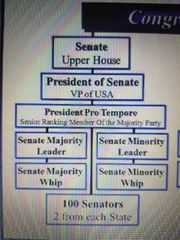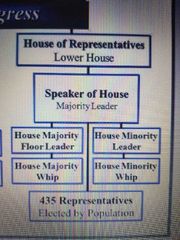![]()
![]()
![]()
Use LEFT and RIGHT arrow keys to navigate between flashcards;
Use UP and DOWN arrow keys to flip the card;
H to show hint;
A reads text to speech;
56 Cards in this Set
- Front
- Back
|
Bicameral |
2 houses or chambers. |
|
|
Senate |
100 members. Two from each state. 6 year terms. |
|
|
Trustees |
Do the right thing. Senators. |
|
|
Delegates |
Do what the people want . House members |
|
|
Leadership structure of the Senate |

|
|
|
House leadership |

Speaker of the house. House majority leader. Majority whip Minority leader.
|
|
|
Speaker of the house |
The chief administrative officer in the House of Representatives. Presides over the chamber on special occasion's. Rules on procedural issues. Chooses members for committees. Asigns legislation to committees. Maintains order and civility. Sets house agenda, determines bill for consideration. Negotiate with senate and executive branch. |
|
|
House majority leader |
The Speakers eyes and ears. Spokesperson, f-manger, negotiator. |
|
|
Majority whip |
Responsible to party discipline |
|
|
How a bill becomes a law |
Draft. Submit to senate Submit to house Committee action F-action Conference committee Presidential action |
|
|
President of the Senate |
Vice president. Only shows for ties and important votes. |
|
|
Majority leader(S) |
Elected by the party. |
|
|
President pro tempore |
Majority party senator with the longest senate service |
|
|
Veto |
A bill passed Congress can be signed or killed by the president t in 10 days. Tell Congress the bill won't pass. Can be overridden by a 2/3 vote from each chamber. 291 votes in the house. 67 votes in the senate.
|
|
|
Qualifications to run for president |
Natural born citizen. Live in the United States for at least 14 years. Be at least 35 years old. |
|
|
Plan of secession |
Vice president, the speaker of the house, the senate pro tempore, the cabinet departments, senators, representatives, state governors. |
|
|
Presidential powers |
Commander in chief. Controls the military but cannot declare war this is reserved by the.
Grants pardons and reprieves for federal crimes only.
Authorizes advice from cabinet members and a vises on the state of the Union |
|
|
Roles of the president |
Commander in chief. (Military) Diplomat. (Advocate) Legislator. (Sets the agenda) Updating the Union. (State of the union address) Veto's. Chief bureaucrat. (Head of executive government) Economist in chief. (Rests in the house but the president is blamed) Head of state. (Cereminial leader) Party leader. |
|
|
Pendleton civil service act |
The law that shifted American government toward a merit based public service1883 |
|
|
Max Weber's model of bureaucracy |
Hierarchy. Division of labor. Fixed routines. Equal roles for all. Technical qualifications. |
|
|
Judicial activism |
A vigorous or active approach to reviewing the other branches of government |
|
|
Judicial restraint |
Reluctance to interfere with the other branches of government |
|
|
Cloture vote |
The senate's only approved method for halting a filibuster or lifting a legislative hold. Requires the approval of 3/5 of the senate-60 votes |
|
|
Reapportionment |
Re organization of the boundaries of the house districts a process that follows the results of the US census taken every 10 years. |
|
|
Executive privlidge |
Power claimed by the president to resist request for authority by Congress the courts or the public. |
|
|
Executive agreements |
An International agreement made by the president that does not require the approval of the senate |
|
|
Signing statements |
Written declarations commenting on the bill that is signed into law |
|
|
Political opponents |
Top officials in the executive agencies appointed by the president |
|
|
Civil servants |
Members of the perminent executive branch bureaucracy who are employed on the basis of competitive exams and keeps their position in regards of the presidential administration |
|
|
Executive order |
A presidential declaration with the force of law that issues instructions to the executive branch without any requirement from congressional action or approval |
|
|
Going public |
Directly a dressing the public to win support for one's self or one's ideas |
|
|
Political order |
The set of institutions interests and ideas that shape a political era |
|
|
The cabinet |
Members have 2 primary roles. They run executive branch departments, and they meet to discuss policy with the president in cabinet meetings |
|
|
The vice president |
In addition to standing by in case of catastrophe, vice presidents preside over the senate and cast a vote in case of a tie. |
|
|
Executive office of the president |
EOP The agencies that help the president manage daily activities |
|
|
Chief of staff |
The individual responsible for managing the president's office |
|
|
Spoils system |
Government jobs given out as political favors |
|
|
Independent regulatory commission's |
Have the authority to issue regulations, enforce laws, and settle disputes. |
|
|
Whistle blower |
A federal worker who reports corruption or fraud |
|
|
Freedom of information act |
A law that facilitates full or partial disclosure of government information and documents 1966 |
|
|
District court |
The 1st level of federal courts, which actually try the cases. Each decision is based not on a statute but on previous judicial decisions. |
|
|
Circuit courts |
The 2nd stage of federal courts, which review the trial record of cases decided in district court to ensure they were settled properly. |
|
|
Judicial review |
The court's authority to strike down acts that violate the Constitution and to interpret what the Constitution means. |
|
|
Common law |
A system of law developed by judges in deciding cases over the centuries |
|
|
Civil law |
Cases that involve disputes between 2 parties |
|
|
Criminal law |
Cases in which someone is charged with breaking the law |
|
|
Amicus curiae |
A brief submitted by a person or group that is not a direct party to the case |
|
|
Rule of four |
The requirement that at least for Supreme Court judges must agreed to hear a case before it comes before the court |
|
|
Majority opinion |
The official statement of the court |
|
|
Concurrent opinion |
A statement that agrees with the majority opinion |
|
|
Dissent |
A statement on behalf of the justices who voted in the minority |
|
|
Requirements to be a member of the house |
Be at least 25 years of age Have been a citizen for the past 7 years Be an inhabitant of the state they represent |
|
|
Requirements to be a member of the senate |
Be at least 30 years old Be a citizen for the past 9 years And reside in the state you wish to represent |
|
|
Current Oklahoma senators |
James Inhofe(senior) James Lankford(junior) |
|
|
Current Oklahoma representatives |
1: Kevin Hern R 2: Markwayne Mullin R 3: Frank Lucas R 4: Tom Cole R 5: Kendra Horn D |
|
|
Gerrymandering |
Redrawing an election district in a way that gives the advantage to one party |

